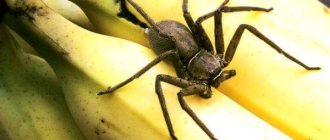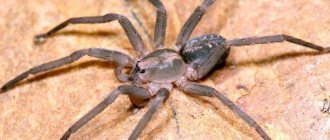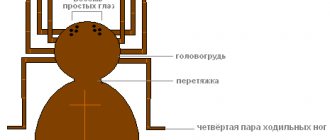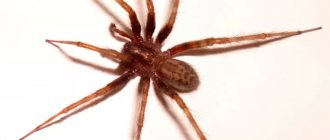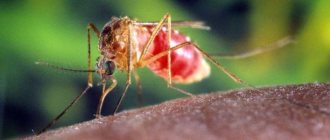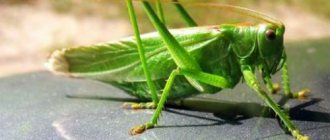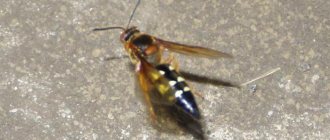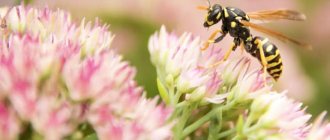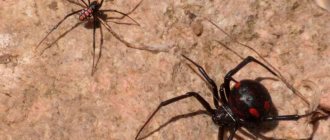Under different names
Author of the photo:
Translated from Latin, the name of the order Solifugae means “running away from the sun.” Two more names are common in the world - phalanges and bihorci.
In the dry regions of Southern Africa they are called "barbers" or "barbers". This is because local tribes have the opinion that arthropods cut off human hair, as well as animal fur, in order to equip their nests with them.
In Asia they are called camel spiders, but in Europe you can hear the names “windy scorpion” or “sun spider”. Residents of Uzbekistan and Turkmenistan call them alli gusola, which means bull's head.
2
Origin of the species and description
Photo: Solpuga
Salpugs are a group of arachnids that have various common names. Salpugs are solitary, have no venom glands and pose no threat to humans, although they are very aggressive and fast-moving and can inflict a painful bite.
The name "solpuga" comes from the Latin "solifuga" (a type of poisonous ant or spider), which in turn comes from "fugere" (to run, fly, escape) and sol (sun). These distinctive creatures have several common names in English and Afrikaan, many of which include the term "spider" or even "scorpion". Although it is neither one nor the other, "spider" is preferable to "scorpion". The term "sun spider" applies to those species that are active during the day, that seek to escape the heat and dart from shadow to shadow, often giving humans the alarming impression that they are stalking them.
Video: Solpuga
The term "red Roman" probably derives from the Afrikaans term "rooiman" (red man) due to the red-brown color of some species. The popular term "haarkeerders" means "protectors" and comes from the strange behavior of some of these animals when they use the animal barn. It seems that the female salpugs considers the hair an ideal liner for the nest. Reports in Gauteng have suggested that salpugs are cutting hair from people's heads without knowing it. Salpugs are not adapted for cutting hair, and until this is proven this must remain a myth, although they are capable of crushing the trunk of bird feathers.
Other names for salpugs include sun spiders, Roman spiders, wind scorpions, wind spiders or camel spiders. Some researchers believe that they are closely related to pseudoscorpions, but this is refuted by recent research.
Body structure
The phalanges are quite large arthropods. For example, adult Central Asian salpugs grow up to 7 cm in length. Other species average from 4 to 5 cm.
Their entire body is covered with small hairs, and their color depends on their habitat. Basically, it is sandy-yellow, brown and even whitish in color. The body is divided into three parts. The head is quite large and convex. The chest is segmented, dividing into three equal parts. But the oblong abdomen has 9–10 segments. They all look pretty scary.
In front are the pedipalps, which resemble limbs. At the end there are powerful claws covered with a powerful shield. Among arachnids, salpugs have the most powerful chelicerae, capable of biting prey in half. Three pairs of limbs are attached to the head section, and the rest to the thoracic segments. The hind limbs of salpugs are much longer than the rest.
Don’t miss the fascinating material on our website most-beauty.ru about the TOP 20 most beautiful spiders in the world.
3
Habits and lifestyle
Unlike other arachnids, they are mobile creatures. Fast predators, capable of speeds of up to 2 km per hour, hunt at night. But there are also daytime hunters. Their victims include ants, termites, species of beetles, and related arthropods. Powerful tentacles allow you to cope with lizards.
They can track their prey by chasing it and then suddenly attacking from behind. We learned to hunt from ambush. They easily gnaw through beehives and termite mounds. They track the prey with their senses of touch, their eyes, and also feel the vibration of the soil.
The lifestyle and behavior of the phalanges combine the features of primitive creatures with signs of high organization. Sensing danger, they throw the back of their body over their head and begin to squeak loudly. This frightening sound is created by the friction of the chelicerae against each other. They jump and spin in place at the same time. To hide from enemies, salpugs dig deep holes and cover the entrances with foliage.
4
Features of character and lifestyle
Photo: Camel spider in Crimea
Bihors are very active. They hunt mainly at night, although diurnal species are also found. During the winter, arthropods hibernate, and some species can do so during the summer months. They received the name “Wind Scorpion” for their ability to move at a speed of 16 kilometers per hour. Large individuals jump at a distance of more than one meter.
These creatures are aggressive, but not at all poisonous, although their bites can have serious consequences. Large individuals are capable of biting through human skin or nails. If rotting remains of their victims are present on the mandibles, they can enter the wound and cause blood poisoning or, at a minimum, inflammation.
Interesting fact: There are many different speculations about the toxicity of animals. For many centuries, salpuga was considered terribly poisonous and dangerous to human life.
The creature is absolutely not afraid of people. At night, phalanxes can easily run into the tent by the light of a lantern, so the entrance should always be closed. And when climbing inside, it’s better to check once again whether the animal has run in with you. Personal belongings also need to be kept in the tent, since a salpuga tired after a night hunt can climb into them to rest.
It is impossible to kick a bihork out of the tent. She is very nimble and persistent, so all that remains is to kill her or sweep her with a broom. It is advisable to do all this with thick gloves, and it is better to tuck your trousers into your boots. It should be remembered that it is impossible to crush an animal on the sand.
Bites
The appearance of salpugs is truly menacing. There is a myth that they are poisonous and can cause human death. But that's not true. The bite is really painful, but does not pose a danger to humans. They have neither poisonous glands nor deadly poison. Some species easily bite through human skin.
The only thing that needs to be done after a bite is to treat the wound to prevent infection. The chelicerae store rotting food debris, which can cause inflammation. And so, this is a completely harmless creature.
By the way, on our website most-beauty.ru you can find a list of the most poisonous spiders on our planet.
5
Benefits and harms
Salpugs not only move at high speed, but are also able to easily climb vertical surfaces and excellently jump over quite a considerable distance. Large species are capable of jumping over a distance of more than a meter. When confronted with an enemy, she assumes a very intimidating pose: the anterior part of the body rises, and the chelicerae and open claws point forward. Some species are capable of making piercing sounds at this moment.
Despite the fact that there is no poison in the salpug's body, all naturally occurring varieties bite quite noticeably and painfully.
Small species of salpuga and young individuals are not able to bite through human skin. However, adult individuals quite often bite through the skin of not only humans, but also animals.
The larvae of some species of hoverflies are predatory and feed on the tissues of various insects. From the secretions of forest ants, scientists have learned to extract formic alcohol, which is part of various medicines against rheumatism, arthritis, tuberculosis, etc. Read the article for a full description of this insect.
In the absence of food, argasid mites can also parasitize humans. Why these insects are dangerous, read the link.
Reproduction
The mating season for different types of phalanges depends on the area of settlement. Mating usually occurs at night. The female attracts males with a special smell.
The male secretes spermatophores and, with the help of chelicerae, transfers them to the genital opening of the female. This entire process takes from 2 to 4 minutes.
After mating, the male quickly runs away so that the female does not satisfy her hunger with him. In the female’s body, the development and formation of fertilized appendages occurs. During this period, she eats a lot, and after a while she lays eggs in a pre-prepared hole in the soil.
Photos and names of species
Now let’s talk in more detail about the species of salpugs that live in different parts of the world.
Social structure and reproduction
Photo: Common salpuga
Reproduction of salpugs may involve direct or indirect transfer of sperm. Male salpugs have air-like flagella on their chelicerae (like backward-facing antennae), uniquely shaped for each species, which likely play a role in mating. Males can use these flagella to insert a spermatophore into the female's genital opening.
The male searches for the female using his suktorny organ, which he snatches from the female from his retreat. The male uses the pedipalps to freeze the female and sometimes massages her abdomen with his chelicerae while he deposits a spermatophore into the female's genital opening.
About 20-200 eggs are produced and hatched over the course of about four weeks. The first stage of salpug development is the larva, and after the shell splits, the pupal stage occurs. Salpugs live for about a year. They are solitary animals that live in cleared sandy shelters, often under rocks and logs or in burrows up to 230 mm deep. The chelicerae are used for digging, with the body bulldozing the sand, or the hind legs are used alternately to clear the sand. They are difficult to keep in captivity and usually die within 1-2 weeks.
Interesting fact: Salpugs go through a number of stages, including the egg, 9-10 pupal instars, and the adult stage.
Common / Galeodes araneoides
This species, common in Russia and Central Asian countries, is also called the South Russian salpuga. In addition to the south of Russia, they are found in the steppes of Ukraine and Kazakhstan. The settlement area stretches from Egypt to Afghanistan.
Adult males reach 6 cm. Females are smaller - no more than 4.5 cm. This species has a sandy-yellow body color, and small dark spots can be seen on the back.
Zoologists believe that the type locality is located within the modern Volgograd region. This species was first described by Russian zoologist Peter Pallas. In 1772, he included the inhabitants of the southern steppes, deserts and semi-deserts in the scientific classification.
Arabian salpuga / Galeodes arabicus
The distribution area of the formidable-looking phalanx is limited to the countries of North Africa and the Arabian Peninsula. The “Arabian” predator feeds on small insects and other arthropods.
They grow up to 5 cm. The entire body and limbs are covered with long hairs. They lead a nocturnal lifestyle, and during the day they hide from the sun and enemies under stones, in burrows, and crevices.
They are not poisonous, and therefore often end up in home terrariums. At home they are quite voracious, but it is better not to overfeed.
Smoky / Galeodes fumigatus
The inhabitant of the desert regions of Turkmenistan has a dark brown color. There are also completely black individuals. This type, of course, can scare.
They grow up to 7 cm in length, and therefore are considered one of the largest representatives of the Galeodes genus. They track their victims at night and hide in holes during the day. Some individuals use the same hole, but most find a new shelter every day.
They move quickly using walking legs. To this ability we add that they can easily overcome obstacles with a vertical surface.
Transcaspian salpuga / Galeodes caspius
This species is also known under the name Camel spider. This name has been assigned to the inhabitants of the steppes of Kazakhstan and Kyrgyzstan, but in fact it is not a spider at all. It looks very menacing, but is not dangerous to humans, as it is not poisonous.
It may hurt to bite. The species is quite aggressive. It can even attack dangerous scorpions. The giant salpuga, growing up to 7 cm, easily copes with the poisonous creature.
The color of the head and chest is brown with a slightly reddish tint. But their abdomen is grayish with dark transverse stripes.
Crimean salpuga
Among the diversity of the world of spiders of Crimea, in the foothill arid regions of the southern part of the peninsula, you can meet beautiful phalanges. Unlike tarantulas and karakurts, they are non-poisonous.
They reach a length of 5 to 6 cm. The color is light. They are active in the dark, hunting insects, small lizards, and scorpions.
This species has a complex structure of visual organs, providing them with a good reaction. They not only see the victim, but also feel its approach through the vibration of the soil. It is noteworthy that they are practically not afraid of humans and can easily join a night rest around a tourist fire.
Phalanx spider (salpuga) - description, structure, characteristics, photo
The phalanx spider can reach a length of 7 cm. The cephalothorax has a dissected structure. On its anterior section, covered with a durable chitinous shield, there are two bulging eyes, large chelicerae (oral appendages) with powerful pincers, short pedipalps with sensitive appendages, and walking legs. In total, the salpuga (phalanx) has 10 legs.
Unlike the front legs, which perform a tactile function, the hind legs of the salpuga are equipped with tenacious claws, between which there are peculiar suction cups. Thanks to this arrangement of limbs, camel spiders easily climb vertical surfaces.
The large abdomen of the phalanx is spindle-shaped and consists of 10 complex segments, each of which is formed by a hard abdominal and dorsal part and is connected to the cephalothorax like a waist.
Salpugs have well-developed tracheal breathing, consisting of powerful longitudinal trunks and a system of small branching air vessels with spiral thickenings of the walls, which permeate the entire body of the camel spider.
The entire body and appendages of these arachnids are covered with a huge number of thin hairs and bristles of varying thickness and length. This unusual “hair” of the salpug, combined with its large size and rapid movements of the phalanges, gives them a rather menacing appearance, allowing them to scare off a potential enemy.
In addition, with the help of chelicerae, salpugs can make grinding or squeaking sounds designed to intimidate the enemy.
One of the characteristics of a phalanx spider is powerful chelicerae. In the structure of each chelicera, there are 2 parts that are held together by a joint. As a result, the chelicera looks like a crab claw, as can be seen in the photo below. The chelicerae of the phalanx contain teeth, the number of which depends on the type of arachnid.
The salpuga's chelicerae are so powerful that they allow it to cut off the fur and feathers of its prey, cut the skin and cut the bones of birds. When in danger, the phalanges squeak or chirp piercingly due to the friction of the chelicerae against each other.
The color of the phalanx spider is determined by its habitat, and salpugs live in desert and arid areas, so most species have a characteristic color in whitish, yellowish and brown tones. As an exception, variegated individuals are observed.
Ammotrechidae
Let's finish with a huge family that includes more than 80 species. Representatives of the family are found in arid places in North and Latin America. One known fossil species, Happlodontus proterus, was found in Dominican amber in Haiti.
All 80 species are united by zoologists into 20 genera. Night predators easily cope with termites, large insects, and small reptiles.
Almost all species were discovered in the twentieth century. Most species live in Venezuela and Chile. The image of salpug is found in the drawings of the Incas and the Mayan tribe.
Who is stronger: Salpuga or Scorpio?
Interesting Facts
Let's finish our story on most-beauty about salpug with interesting facts about these amazing arachnids.
- It is known that the species name of salpugs is “running away suns,” but in Spain they are called “sun spiders.” The Central Asian sun-loving salfug, Paragaleodes heliophilus, also runs around the steppe during the day.
- If a salpug is given a sufficient amount of food, which does not require hunting, it will eat until its belly bursts.
- Quite brave inhabitants of the planet. Without fear, she attacks animals that are many times larger than her.
- About 50 species live in the southern regions of Russia. Many of them are listed in the Red Book.
- On YouTube you can find videos where the salpuga fights against a tarantula, fights centipedes and other poisonous creatures.
- They run fast, covering 52 cm in 1 second. They can also jump up to a meter in length, and some can jump 3 meters in height.
- In 1913, the oldest fossil species, Protosolpuga carbonaria Petrunkevitch, was discovered in the United States. It was found in sediments of the Carboniferous period. Thus, the first phalanges appeared on earth 340–300 million years ago.
- Salpuga is rarely found in the mythology of peoples, but on a series of animal stamps from Kazakhstan there is a drawing of this amazing inhabitant of the steppes.
Where does the camel spider live?
Photo: Camel spider in the desert
Bihors are inhabitants of desert, arid, steppe areas with a tropical and subtropical climate. They can sometimes be found in temperate regions. Only a few species of phalanges have adapted to life in forests. The largest number is concentrated in the Old World. Representatives of the families Eremobatidae and Ammotrechidae can only be found in the New World.
In the Old World, arachnids are distributed throughout almost all of Africa, with the exception of Madagascar, in South, Western and Central Asia. Despite ideal habitat conditions, arthropods do not live in Australia and the Pacific Islands.
Several families live in the Palearctic, two endemics live in South Africa. The range also extends to India, Bhutan, Sri Lanka, Pakistan, and in Western Europe - the Balkan and Iberian Peninsula, Greece, Spain. Unsuitable living conditions do not allow inhabiting the Arctic and Antarctica.
In the countries of the former USSR, bihors live throughout Central Asia - in Tajikistan, Turkmenistan, Kazakhstan, Uzbekistan, Kyrgyzstan. They are found in Transcaucasia, the Northern Caucasus, Kalmykia, the Gobi Desert, Astrakhan, the Lower Volga region, and the Crimean Peninsula. Some species are found at altitudes of up to 3 thousand meters above sea level.
Now you know where the camel spider is found. Let's find out what he eats.
Conclusion
Many species are listed in the Red Book, receiving the status of endangered species. As we have learned, this is a safe predator. But salpugs, like all spiders, cause genuine fear in most inhabitants of the earth, which is why arachnophobia is the most common of all phobias.
The editors of most-beauty.ru ask you not to stand aside, but to add your opinion about salpugs in the comments to this article, and perhaps share your personal experience of meeting these amazing animals.

